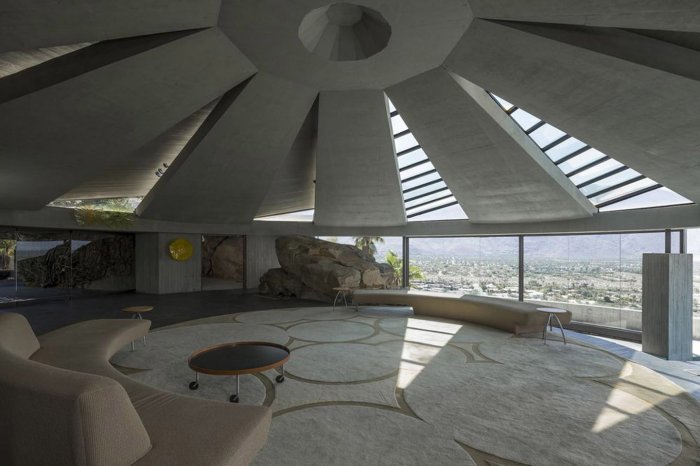Lautner House: A Masterpiece of Modern Architecture
Kicking off with Lautner House: A Masterpiece of Modern Architecture, this opening paragraph is designed to captivate and engage the readers, providing an overview of the iconic architectural gem that is the Lautner House.
Delving into its history, architectural style, and significance in modern architecture, the Lautner House stands as a testament to innovative design and timeless beauty.
Overview of the Lautner House
The Lautner House, also known as the Silvertop residence, is a masterpiece of modern architecture located in Los Angeles, California. Designed by renowned architect John Lautner, the house was completed in 1963 for industrialist Kenneth Reiner.
Architectural Style of the Lautner House
The Lautner House is a prime example of Lautner's organic architecture, which seamlessly blends with its natural surroundings. The house features sweeping concrete curves, expansive glass walls, and a unique domed concrete roof that mimics the shape of the surrounding hills.
Lautner's innovative use of materials and attention to detail create a harmonious connection between the interior and exterior spaces.
Significance of the Lautner House in Modern Architecture
The Lautner House is considered a groundbreaking work in modern architecture for its innovative design and structural engineering. Its futuristic aesthetics and integration with the environment have inspired countless architects and designers around the world. The house showcases Lautner's visionary approach to architecture, pushing boundaries and redefining the concept of residential living.
Architectural Features

The Lautner House, designed by architect John Lautner, showcases several key architectural features that set it apart as a masterpiece of modern architecture.
Integration with Surroundings
The design of the Lautner House seamlessly integrates with its natural surroundings, blending in with the landscape rather than overpowering it. The use of expansive glass walls allows for uninterrupted views of the surrounding environment, creating a harmonious relationship between the interior and exterior spaces.
Use of Materials
In the construction of the Lautner House, John Lautner employed a combination of innovative materials to achieve his vision. Concrete, wood, and glass are prominently featured, with each material serving a specific purpose in the overall design. The use of concrete provides structural stability, while wood adds warmth and texture to the interior spaces.
Glass plays a crucial role in connecting the inhabitants with the outside world, flooding the interiors with natural light and offering panoramic views of the landscape.
Interior Design
The interior design of the Lautner House is a stunning display of modern architecture at its finest. Designed to seamlessly blend with the surrounding environment, the layout and interior spaces are both functional and aesthetically pleasing.
Layout and Interior Spaces
The Lautner House features an open floor plan that creates a sense of spaciousness and connectivity between the various living areas. The living room, dining area, and kitchen flow effortlessly into one another, creating a cohesive living space that is perfect for entertaining or simply relaxing.
The bedrooms are strategically placed to maximize privacy and offer stunning views of the surrounding landscape.
Natural Light Utilization
Natural light plays a key role in the interior design of the Lautner House. Large windows and skylights are strategically placed throughout the home to maximize the amount of natural light that enters the space. This not only helps to reduce the need for artificial lighting but also creates a bright and airy atmosphere that enhances the overall aesthetic of the home.
Unique Design Elements
One of the most distinctive design elements of the Lautner House is the use of organic shapes and materials. The curved walls and unconventional angles give the interior a sense of movement and fluidity, while the use of natural materials such as wood and stone adds warmth and texture to the space.
Additionally, the integration of built-in furniture and storage solutions helps to maximize space and create a clean, minimalist aesthetic throughout the home.
Influence and Legacy
The Lautner House, with its innovative design and unique architectural features, has left a lasting impact on contemporary architecture. Architects and designers continue to draw inspiration from its principles, adapting and incorporating elements of its design into modern structures.
Architectural Influence
The Lautner House's open floor plan, seamless indoor-outdoor connection, and use of natural materials have been replicated in many contemporary homes. Architects have embraced the concept of blurring boundaries between interior and exterior spaces, creating a harmonious flow that enhances the overall living experience.
- The integration of large glass walls and expansive windows to maximize natural light and views has become a prominent feature in modern architecture.
- The emphasis on sustainability and eco-friendly design, reflected in the use of recycled materials and energy-efficient systems, can be traced back to the Lautner House.
- The incorporation of organic shapes and innovative structural solutions, such as cantilevered roofs and unconventional building materials, has influenced the way architects approach structural design.
Legacy in the Architectural World
The legacy of the Lautner House extends beyond its physical presence, as it has become a symbol of architectural excellence and creativity. Architects and enthusiasts alike continue to study and admire its design, recognizing it as a masterpiece that transcends time.
- John Lautner's visionary approach to architecture, characterized by a deep respect for nature and a commitment to pushing boundaries, has inspired a new generation of architects to think outside the box.
- The Lautner House serves as a reminder that architecture is not just about creating buildings, but about shaping experiences and fostering connections between people and their surroundings.
- Its enduring influence can be seen in the way contemporary architects strive to create spaces that are not only visually striking but also functional, sustainable, and enriching for those who inhabit them.
Closing Notes

In conclusion, the Lautner House continues to inspire and influence the world of architecture with its unique features and lasting legacy. It remains a true masterpiece of modern design that will always captivate those who appreciate the art of architecture.
Top FAQs
What is the history of the Lautner House?
The Lautner House was designed by architect John Lautner in 1949 for the Chemosphere family in Los Angeles, California.
How does the design of the Lautner House integrate with its surroundings?
The Lautner House's design incorporates natural elements and uses materials that blend harmoniously with the environment, creating a seamless connection between the structure and its surroundings.
What are some unique design elements of the Lautner House?
The Lautner House features innovative use of materials, open floor plans, and large windows that emphasize natural light and the surrounding landscape.




